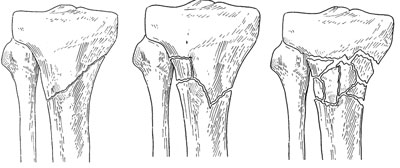Proximal Tibia Fracture
Article by Dr. Darren R Keiser MD
A fracture, or break, in the shinbone just below the knee is called a proximal tibia fracture. The proximal tibia is the upper portion of the bone where it widens to help form the knee joint. In addition to the broken bone, soft tissues (skin, muscle, nerves, blood vessels, and ligaments) may be injured at the time of the fracture. Both the broken bone and any soft-tissue injuries must be treated together. In many cases, surgery is required to restore strength, motion, and stability to the leg, and reduce the risk for arthritis.
Description

Examples of different types of Proximal Tibia Fractures.
Sometimes these fractures extend into the knee joint and separate the surface of the bone into a few (or many) parts. These types of fractures are called intra-articular or tibial plateau fractures.
The top surface of the tibia (the tibial plateau) is made of cancellous bone, which has a “honeycombed” appearance and is softer than the thicker bone lower in the tibia. Fractures that involve the tibial plateau occur when a force drives the lower end of the thighbone (femur) into the soft bone of the tibial plateau, similar to a die punch. The impact often causes the cancellous bone to compress and remain sunken, as if it were a piece of styrofoam that has been stepped on.
This damage to the surface of the bone may result in improper limb alignment, and over time may contribute to arthritis, instability, and loss of motion.
Cause
A fracture of the upper tibia can occur from stress (minor breaks from unusual excessive activity) or from already compromised bone (as in cancer or infection). Most, however, are the result of trauma (injury). Young people experience these fractures often as a result of a high-energy injury, such as a fall from considerable height, sports-related trauma, and motor vehicle accidents. Older persons with poorer quality bone often require only low-energy injury (fall from a standing position) to create these fractures.
**
Call the office of Dr. Darren Keiser to set up an appointment
Article URL: http://orthoinfo.aaos.org/topic.cfm?topic=A00393&webid=2FDDE053